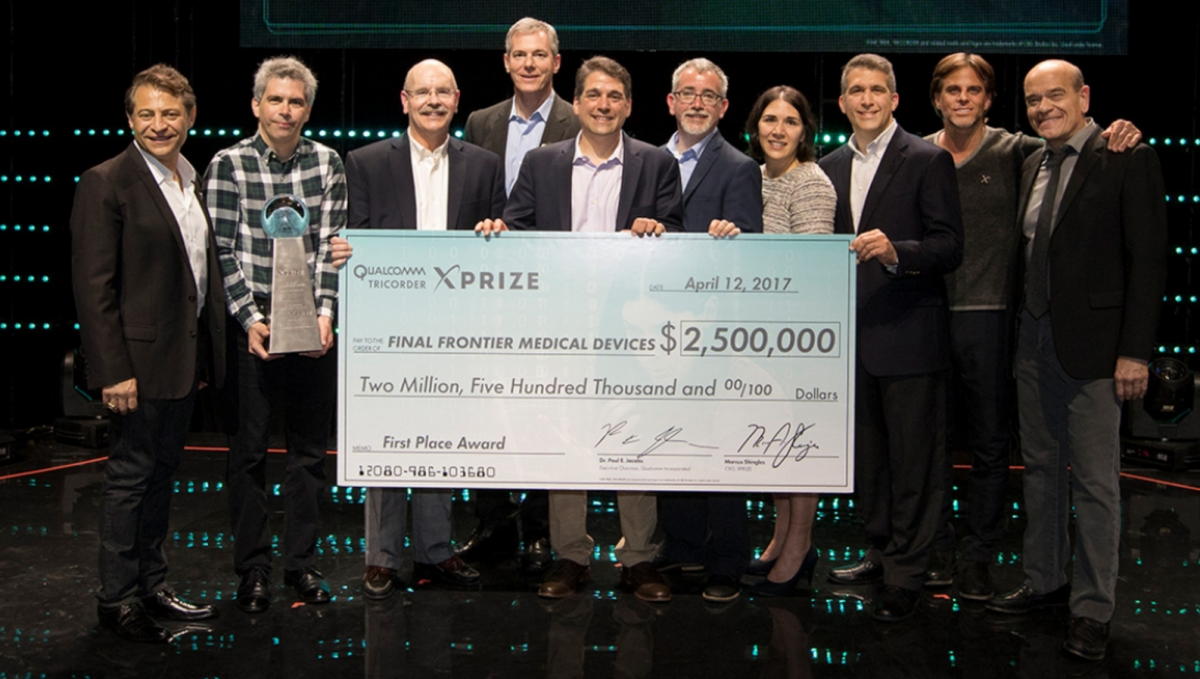 Compared to the time between now and Star Trek's 23rd Century, 2012 isn't too long ago. But it’s been long road for the teams of engineers who participated in the Qualcomm-backed Tricorder X Prize competition. There was immediate interest when the challenge to build a real-life Tricorder – a handheld medical scanner as depicted in Star Trek – was first announced at CES at 2012, with 255 teams initially registered to vie for the $10 million prize. Read on for a look back at the process -- you can follow the hyperlinks to our coverage at the time.
Compared to the time between now and Star Trek's 23rd Century, 2012 isn't too long ago. But it’s been long road for the teams of engineers who participated in the Qualcomm-backed Tricorder X Prize competition. There was immediate interest when the challenge to build a real-life Tricorder – a handheld medical scanner as depicted in Star Trek – was first announced at CES at 2012, with 255 teams initially registered to vie for the $10 million prize. Read on for a look back at the process -- you can follow the hyperlinks to our coverage at the time.
By the time the competition was officially underway in November 2013, that number had dwindled to 34 teams who had completed the full registration and paid $5,000 to $10,000 in entry fees (depending on when they registered). The teams really ran the gamut across skill level, funding and expertise, and included everything from large public companies and Silicon Valley startups to college teams and even one from high school.
Most operated in stealth mode, but a few started making waves in media and crowdfunding. Mountain View, California-based Scanadu broke Indiegogo records with the $1.37 million it raised for SCOUT. Aezon, a group of college students at Johns Hopkins University, also took to Indiegogo in an attempt to raise $10,000 to support its efforts.
After shattering funding records, Scanadu had some setbacks. A six-month delay on their delivery lost them 100 backers. It also ran into some trouble with clarity in communicating to early testers: the company was able to offer the not-yet-cleared device to backers as a reward by making all backers usability testers in a pre-clearance trial, run in conjunction with Scripps Medical Center. There was a loophole however: Emails to backers suggested they could opt-in to the usability study and then opt-out after receiving their devices, thus receiving a unit without participating in the trial (the company denied to MobiHealthNews that it was encouraging this behavior).
The company began shipping devices in April 2014, but found a handful of issues with Scout and its manufacturing process. Scanadu had sent its backers online forms and surveys to fill out to be a part of a usability study run by Scripps Translational Science Institute, and for the first time it became clear that not participating in the study meant not getting a Scanadu Scout pre-FDA. By December 2016, Scanadu was still raising money, reporting a round of $6.5 million.
As of May 2014, there were 30 teams still vying for the prize. Four teams dropped out and the X Prize team released 30 YouTube videos for the remaining entrants, offering a podium for teams to refine their pitch and garner more interest.
In August 2014, the 10 finalists were announced: Scanadu, Aezon, CloudDX, Danvantri, DMI, Dynamical Biomarkers Group, Final Frontier Medical Devices, MESI Simplyfying Diagnostics, SCANurse and zensor. There were a few surprises on who didn’t make the cut, such as Nanobioysm, which had won the Nokia Sensing X Prize. Team Gen Z, the high school team led by then-16-year-old Jack Andraka, was among one of the more talked-about teams that also did not make finals.
By April 2015, Scanadu and Intelesens (makers of the Zensor device) had merged into one team. Both Zensor, which purports to monitor ECG, respiration, and movement, and the Scout, which originally planned to measure pulse transit time, heart rate, electrical heart activity, body temperature, heart rate variability, and blood oxygenation, are still in the midst of their FDA clearance processes. While Zensor's 510(k) application was fairly traditional (at the time, their team leader predicted clearance in three months), Scanadu's was somewhat novel: the company was in the process of shipping "investigational devices" to consumers in advance of FDA clearance.
The group got even smaller when UK-based SCANurse dropped out, or rather, were forced to drop out because their prototype was held up in customs and they were not able to deliver by the deadline.
In January 2016, Tricorder X Prize officials extended the deadline and loosened some requirements, giving seven remaining contestants some extra time to get their devices competition-ready. By December, the competition was down to two teams – Final Frontier Medical Devices and Dynamical Biomarkers – for the top prizes, with five other finalists.
The winner was finally announced on April 12, with Final Frontier Medical Devices taking home the top prize of $2.6 million. The runner-up prize of $1 million went to Dynamical Biomarkers Group. While the actual competition may be over, the X Prize foundation will continue to support the seven finalists with bringing their tricorder devices to market. The balance of the $10 million (sans the $1 million given out as milestone prizes over the course of the competition) will fund these initiatives. You can read more about Wednesday's news here.















